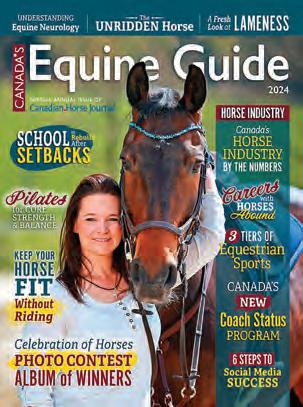






By Madeline Boast, MSc. Equine Nutrition
Q: Fact or fiction? Horses require grains to be fed in their diet to meet their nutritional needs.
A: Fiction!
Grains are not a required feed ingredient for horses, and reducing the amount of grain-based products fed to horses has been a popular trend in recent years.
Grains have developed a poorer reputation in equine nutrition due to their higher nonstructural carbohydrate content. Most horse owners understand that forage is
almost always the preferable energy source to promote gastrointestinal health; however, understanding optimal feed supplementation for the varying needs of horses is imperative to well-being. With “grain-free” becoming a hot topic, there are many misconceptions throughout the industry. Understanding what grain-free means is valuable when designing your own horse’s nutritional plan, especially for active horses.
The Association of American Feed Control Officials defines grains as “a seed from cereal
plants.” A few examples of various grains are oats, corn, wheat, and barley. Where the confusion often begins is when a different part of the grain is used.
There are four distinct parts to a grain: the germ, the endosperm, the hull, and the bran. This can be confusing for horse owners to navigate as even though the product may not contain full oats, corn, barley, or wheat, the feed product may still contain the hulls, for example.
A product can be labelled as grain-free if the intact seed portion is not included. This means that other parts such as the hull may be used despite the product being labelled as grain-free. In equine

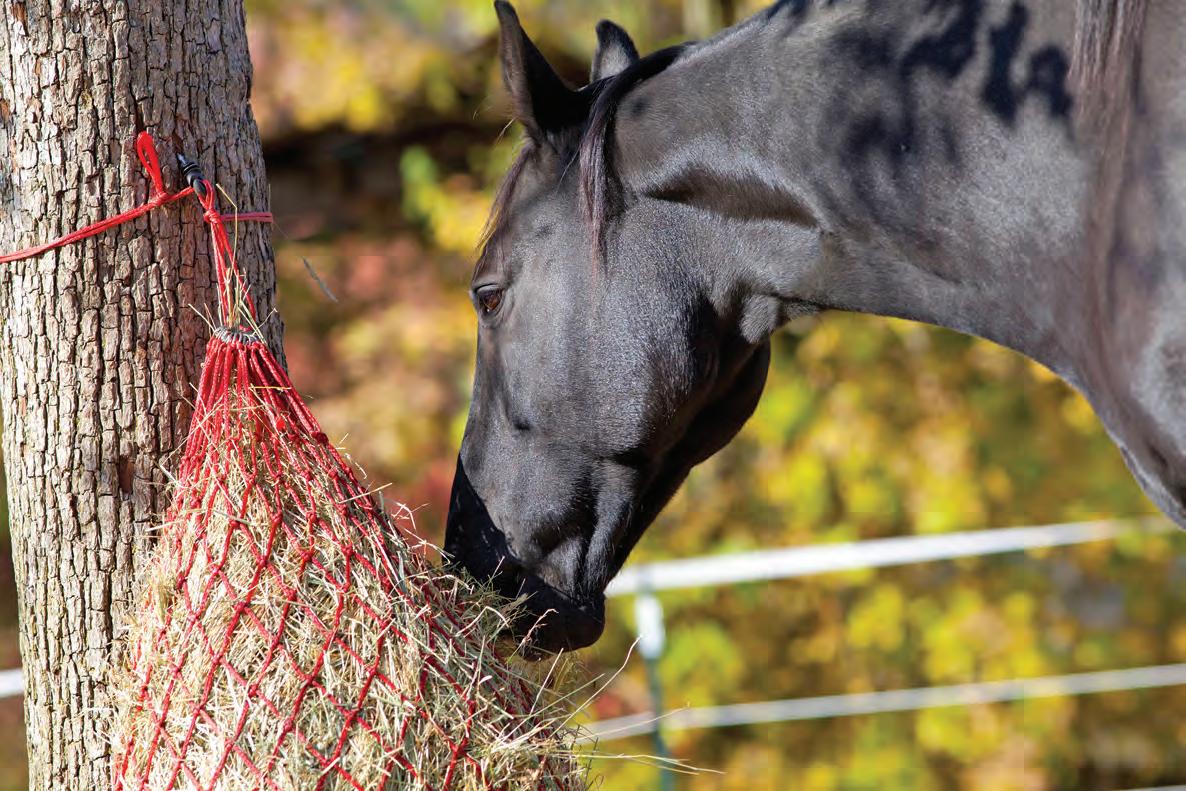

nutrition it is extremely common for the hull and bran to be used as they are very fibrous. Therefore, even if a product is labelled grain-free, it may have parts of the grain used as ingredients.
Another popular misconception regarding grains for horses is that any product that is pelleted is commonly referred to as “grain.” Therefore, a key part of understanding grain-free diets is understanding what a grain is.
In addition, it is important to note that concentrate products are processed (e.g., extruded, pelleted, cracked) to improve digestibility, palatability, reduce the ability of the horse to sort ingredients, and eliminate dust.
Investigating concentrate products comes down to reviewing the guaranteed analysis and reading the ingredient list. There are a variety of products on the market that are pelleted or extruded concentrates and labelled “grain-free” but do contain the hull, for example. This does
As forage alone will not meet your horse’s nutritional requirements, the first step to designing your horse’s nutritional plan is to have your hay analyzed to determine its nutritional value.
not tend to be problematic as those products are high in fibre and lower in starch and sugar than the grain-based products.
Although grains are not required for a balanced diet, forage alone will not suffice. The majority of a horse’s diet is almost always hay, which is recommended for gastrointestinal health, but hay alone will not meet nutrient requirements.
The Nutrient Requirements of Horses, Sixth Revised Edition (2007), published by the National Research Council (NRC), has published recommendations to prevent nutritional deficiency. The six required nutrient categories for horses are water, protein, carbohydrates, fat, vitamins, and minerals. A quality forage will typically meet the energy and protein requirements of most inactive or light riding horses, but vitamins and minerals must be supplemented.
By Monique Noble

Canadian equestrians breathe a sigh of relief when long-awaited spring weather finally arrives and the outdoor riding season begins in earnest. Time to fit up our horses and ourselves for trails, competitions, and the pleasure of spending time outdoors, finally free of the layers of winter gear and horse hair that come with the chillier seasons…
As we head for the outdoor ring or start down our favourite trail, it’s heartbreaking to see that tell-tale orange tint in the sky. Fire doesn’t have to be close for your plans to go, well, up in smoke. Equestrians across the country are getting used to seeing smoky skies as researchers recommend “learning to live with fire.”
An extended and record-breaking 2023 wildfire season saw states of emergency and evacuations across Canada. With plumes of smoke drifting across the country, even those not among the nearly 200,000 evacuees were impacted by poor air quality, the oppressive pall of smoke in the air, and devastating losses as over 18 million hectares of land went up in smoke.
Quebec had more than 120 fires ignite in one day in 2023, as arid conditions associated with climate change led to incredibly dry underbrush that could light with a single spark.
As predicted, the 2024 wildfire season has arrived early, and as if to prove this point, the fire threat here in Alberta was made abundantly clear just yesterday as I drove past a smouldering coulee sparked by a blown tire; thankfully, it was quickly tamed by local firefighters.
My local grassfire may have been subdued but some overwintered fires from 2023 that burned under blankets of snow are still smouldering and will reemerge in spring as temperatures rise. On February 21, 2024, CBC News reported

that there were still 92 active overwintering fires in British Columbia (BC) and 54 in Alberta.
With little snowpack accumulated over an unseasonably warm winter and increasing temperatures bringing hot and dry conditions across Canada, an above normal spring fire risk is predicted for Southern Quebec, Eastern Ontario, and Northern BC with similar conditions affecting the rest of BC, the prairies, and Northern Ontario later in the season.
The Northwest Territories (NWT) is also expected to have drought conditions until later in the year and is preparing for another difficult wildfire season. In 2023, the NWT saw more than four million hectares of forest burned and the
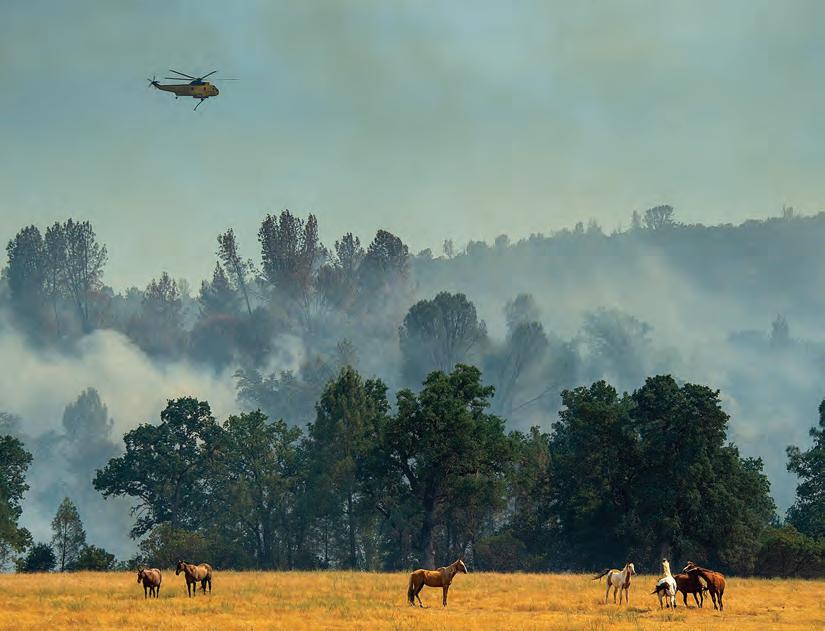

evacuation of 12 communities including the entire city of Yellowknife and its environs. Hot, dry conditions and low water levels throughout the NWT and Alberta also cause water sources required for fighting fires to be less reliable for water procurement. First responders, environmentalists, and horse enthusiasts alike are all hoping that El Niño will give way to his somewhat gentler, cooler sister
La Niña this fall. Unfortunately, with abnormally dry conditions present across most of Canada it seems that this summer we can expect more smoky, hazy days ahead of us, and we should be prepared for them.
There is very little you can do to prepare your horse for smoke inhalation. Even horses housed indoors are exposed to smoke as it circulates through ventilation systems and pervades the air. As horse owners, the best thing we can do is educate ourselves and pay attention to air quality and the signs our horses are giving us.
A horse’s lungs are massive; they move more than 2,000 litres of air per minute during heavy exercise, and they also have 50 times more alveoli than human lungs. Alveoli are the microscopic air sacs within our lungs where gas exchange occurs. That alone makes horses incredibly susceptible to respiratory issues when there are impurities like smoke in the air. Horses are also obligate nose breathers, which means they cannot breathe through their mouths like humans can. With only one way to breathe it is vital our horses’ nasal passages remain free of blockages and irritants.




By Crystal Lee, DVM, DACVS, Burwash Equine Services
If you own horses, you will experience an emergency with them at one point or another. Whether it’s a pawing, painful, thrashing gelding showing signs of colic or a mare who came up suddenly lame because she stepped on a nail during your trail ride, it is important that you know what to expect and what to do.
Colic is the most common emergency that horses experience and that equine veterinarians treat. Although less than 10 percent of all colics are severe enough to require surgery or result in the death of
the horse, it can be very difficult (if not impossible) to know at the onset of the emergency which direction things will go.
A horse experiencing signs of colic will be disinterested in feed, and will
potentially show signs of abdominal pain such as pawing, looking at their flank, and rolling. Less commonly known signs include stretching out as if to urinate, inappropriate sweating, and depression. The range of causes of colic can include anything from a buildup of gas in the intestines to the death of certain sections of the intestines resulting from the loss of the blood supply to those intestines.
A veterinarian treating a colic will be looking to ascertain what might be causing the colic signs to determine how best to treat the problem. Most often, the veterinarian will perform a rectal exam.
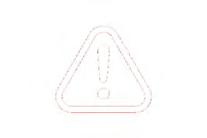


This allows them to palpate portions of the abdomen to feel gas or fluid-distended intestines, intestines impacted with feed material, or intestines displaced within the abdomen. The veterinarian will usually also pass a stomach tube in order to see whether there is any intestinal reflux that flows out of the stomach through the tube. Horses with obstructions or inflammation of their small intestine will have the fluid from the small intestine back up into the stomach, causing reflux. Since horses can’t vomit, it is essential to release the fluid from their stomach with the tube so that their stomach doesn’t rupture.



By Monique Noble
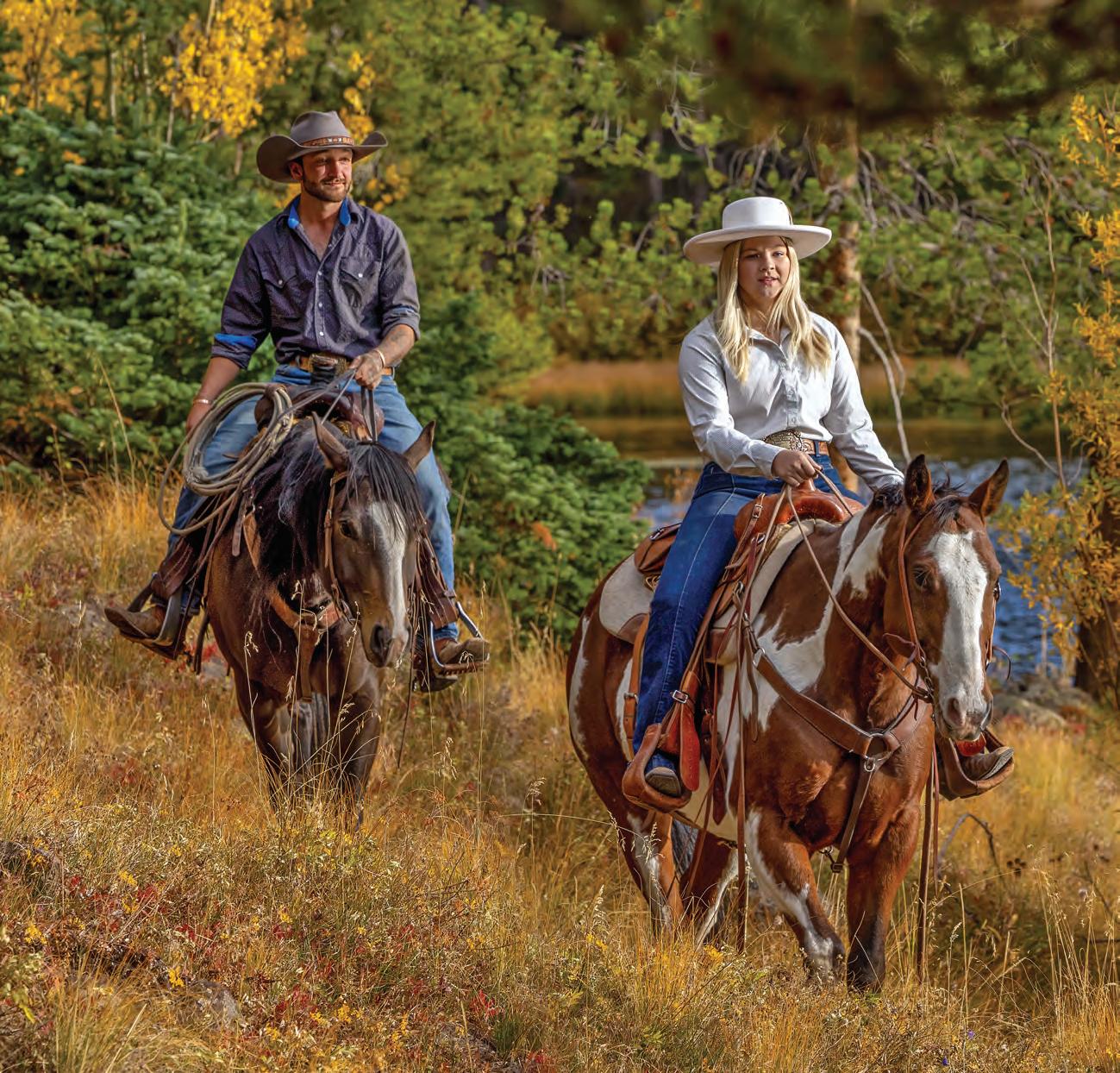
Not much can gross out a horse person. We happily pick out hoofs, observe the quality of manure, scrape bot eggs off our horses’ legs, and get a weird sense of satisfaction from an expressed abscess. But ticks… ticks are just nasty.
Ticks have been found in almost every region of Canada and are becoming more prevalent. There are many theories as to why. Migratory birds and animals transport ticks from one area to another, and shorter, less intense winters resulting from climate change contribute to their survival rate. Thank goodness ticks can’t fly! The fact remains that ticks are here and expanding their range in Canada — what can we do?
Often referred to as an insect, ticks are a member of the arachnid family along with spiders, mites, and scorpions. Ticks have four pairs of legs, and no antennae. There are many different types of ticks in Canada but the ones we see most frequently are dog ticks, lone star ticks, and deer ticks (also known as blacklegged ticks, of which there are two types: the black-legged tick


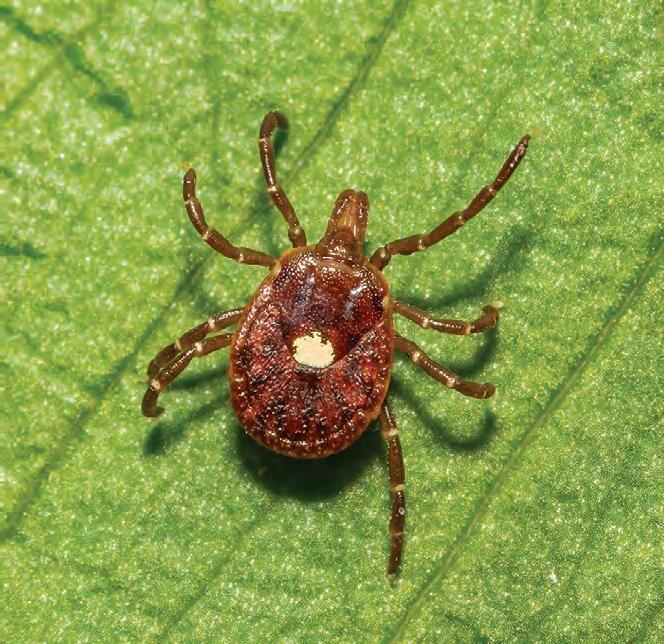
Ticks are found in many areas across Canada, but they prefer wooded areas, tall grasses, and under leaf litter. In urban areas they are found in parks and green spaces.
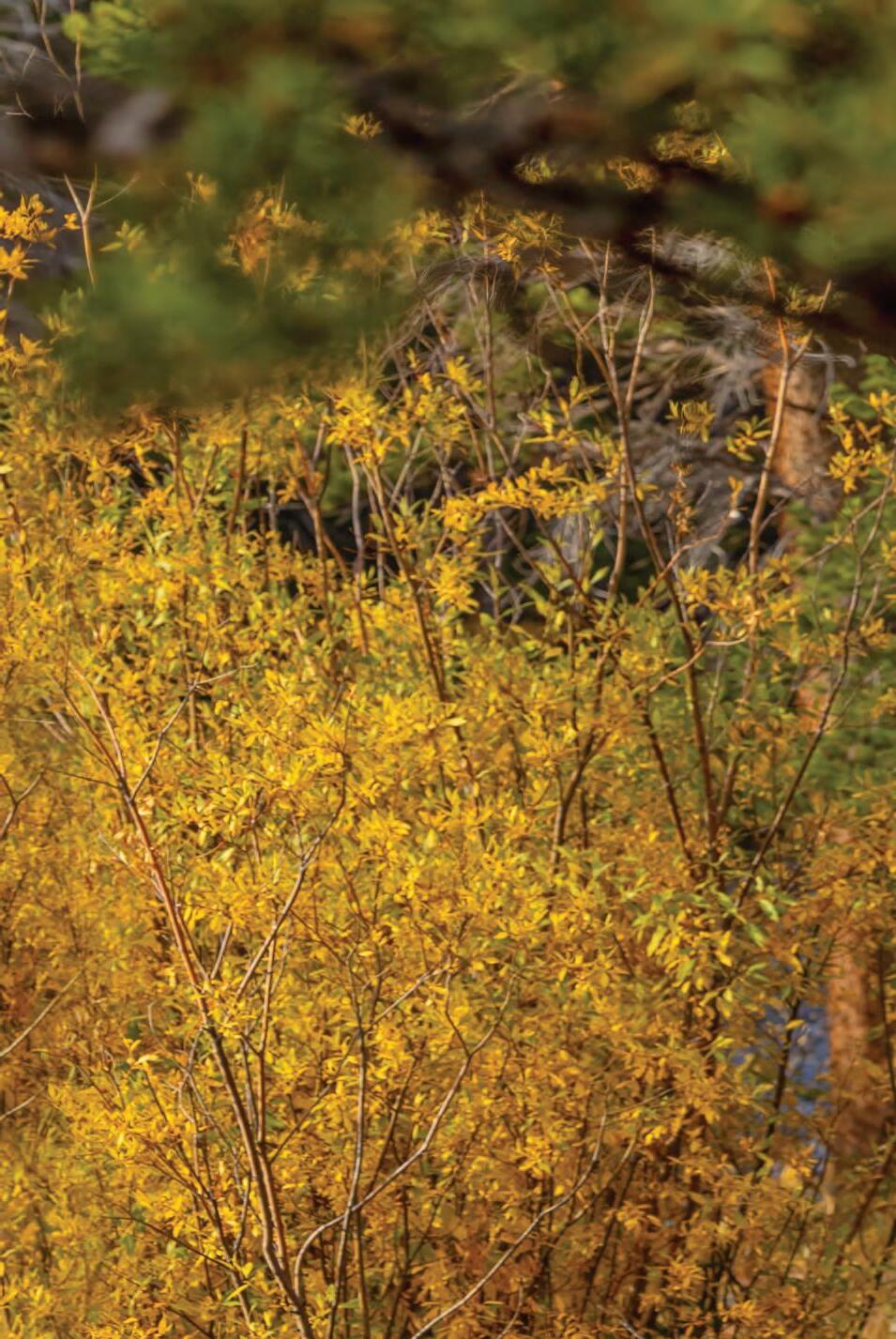
and the Western black-legged tick.). It is the black-legged tick that can carry Lyme disease, anaplasmosis, and, more frequently seen though previously rare in Canada, babiosis.
We want to control exposure to ticks but preventing tick bites and practicing good horse stewardship can seem at crosspurposes. Long tall grass is a beautiful sight to both horse and horse owner, but it’s a favourite hangout for ticks. Chickens and guinea fowl are fantastic for tick control but not everyone has the desire or ability to keep chickens. Removal of tick habitat and natural pest control are not always options. The best course of action for our equine partners is thorough grooming and monitoring daily, and the application of topical repellents. Repellents are the first line of defense for your horse and


How to reduce the risk, recognize the symptoms, and take steps to manage an outbreak.

The bacteria can spread via contaminated equipment such as shared feed tubs, halters, grooming equipment, stall walls, fencing, and even on the hair coat of other barn pets.
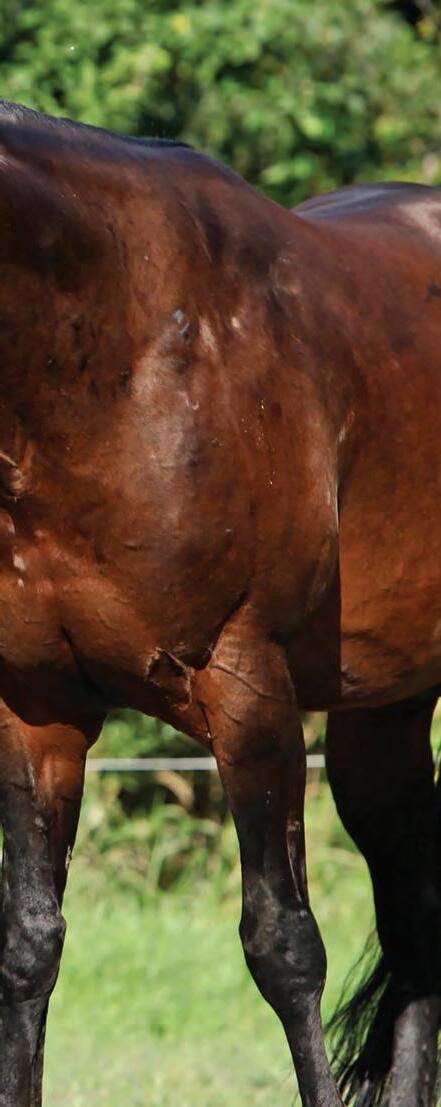

Strangles is a highly contagious infection caused by the bacterium, Streptococcus equi (S. equi). It is not an airborne virus. Rather, the bacteria spreads through contact, which could be direct nose-to-nose between horses, or via contaminated surfaces or equipment such as shared halters, lead shanks, cross-ties, feed tubs, stall walls, fencing, clothing, hands, the hair coat from other barn pets, grooming tools, water buckets, and communal troughs.
Although rarely fatal, strangles is a respiratory disease that can make your horse miserable for a few weeks, and recovering horses can shed the bacteria for four weeks or longer. Three to fourteen days is the typical length of time from infection to the manifestation of clinical sign. Swift control measures will help minimize transmission, reduce associated medical expenses, and decrease the duration of facility “lockdown.”
Severe inflammation of the mucosa of the head and throat, often with extensive swelling and rupture of the lymph nodes below and behind the jaw, which can produce large amounts of thick, creamy pus, are classic signs of strangles.

A purulent nasal discharge, which may initially be clear, is a typical symptom of strangles. Once strangles is confirmed, the horse should be isolated for at least four weeks AFTER the resolution of clinical signs.
Still, not all horses will develop enlarged and abscessed lymph nodes. Some will present with only slight nasal discharge, while others may be lethargic, lose their appetite, and have difficulty breathing and swallowing due to lymph node enlargement around the throat area. In very rare circumstances, “bastard strangles” may develop with abscesses in the abdomen, chest or brain; others may develop immunemediated diseases of skin or muscle.
Fever is an initial sign of strangles, and the beginning of a brief window of one or two days before the horse starts shedding
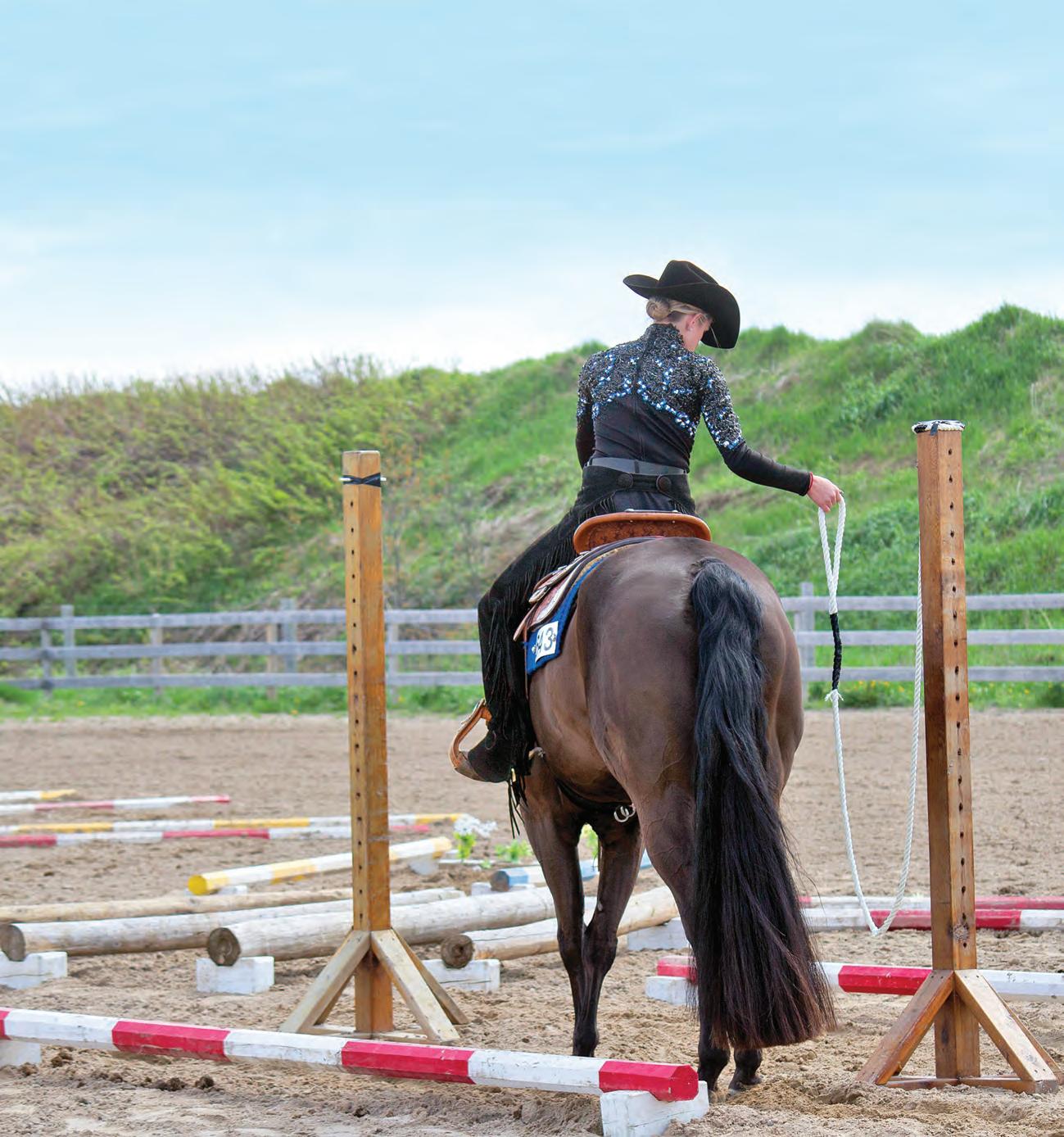
To navigate this show gate, the rider wraps her horse around her inside leg to create a nice arc as he follows his nose. Riding through a gate smoothly, without hesitation in the stride or resistance to the aids, could earn a top obstacle score.
...in the schooling ring and in the show ring
By Lindsay Grice, Equestrian Canada coach and judge

Essentially, a gate is a transition from here to there. It’s a transition from one pasture to another, replicated in competition.
Learning to work a gate can be part of your horse’s training transition into a more attentive, patient, and handy partner.
I use gate training as a transition in the rhythm of a schooling session. For example, after canter work, a slower maneuvering task such as a sidepass, backing obstacle, or gate provides a “commercial break.” The value of teaching your horse the steps to work a trail gate is comparable to the benefit of phonics in learning to read. Mastery of maneuvering his body parts and controlling his feet as well as the patience and listening skills your horse will develop will spill over into other dimensions of his training.
Beyond its cross-discipline educational benefit, competing in trail and other obstacle classes is a lot of fun and growing in popularity. As a judge, I assess and score riders working gates in show trail and ranch classes, Mountain Trail, Working Equitation and Extreme Cowboy. The common denominator across disciplines is style — finesse, flow, and efficiency.
3 ESSENTIAL INGREDIENTS
1 PATIENCE
Maneuvering obstacles — gates, sidepassing, and backing obstacles — require slow training, patience, and pausing between steps. Riders tend to find them boring and consequently, many just don’t practice them (until they get to the horse shows). Moreover, horses are inclined to want to get maneuvering obstacles over with. Not because they’re boring, but because they’re scary.
Naturally, a horse initially feels vulnerable while parked close beside a barrier while his rider reaches down to move it. Horses don’t like to feel trapped between the rider’s leg and an impediment to escape. I want my horse to learn that the gate is a happy place to be — a place to catch his breath, not hold his breath. Don’t work on a gate when your horse is fresh. Wait until he’s relaxed in your schooling session and welcoming a break.
Wait between each step until the horse is completely neutral and not anticipating what comes next. Gradually, you can shorten the wait time until it’s no longer visible — the steps become steady, but the pause is still understood. In other words, the horse never initiates a step but instead, waits to be asked.
2 COMMUNICATION CLARITY
Vague cues will only add to your horse’s feeling of vulnerability. Don’t make your horse guess what you want him to do with his feet. As with all training, start with clear distinction between your leg positions and rein signals in the skill acquisition phase. These aids can soften and become more subtle as your horse gets the idea.
3 CONTROL OF THE HORSE’S FEET
Don’t think of “riding through the gate,” but rather, as a sum of the multiple pieces involved. Before my students approach a gate, we have these five pieces firmly in place: turn on the forehand, turn on the haunches, sidepass, step-backward, and


Anticipation is the most common gate issue I see as a judge. As a clinician, a frequent horse puzzle I’m asked to help solve is how to untrain a horse that has learned to do the gate on autopilot. Of course, the best way to prevent an unwanted habit is not letting a groove ever get established. Interrupting a horse’s familiar pattern takes time — waiting in between steps until the horse settles and mixing up the routine. Keeping a horse guessing keeps him interested in his job and his expression fresh.

By Sarah Mellings, EC Licensed Competition coach
Whenever I coach a new group of riders at a clinic or in a lesson, I am always surprised at how few people can tell me the five different rein aids and the purpose of each. Therefore, it is always a question I like to throw out to the group. I usually see people looking down and moving their hands around, some vague stares, and the occasional rider being able to describe at least one or two of the five.
Rein aids are fundamental communication tools between rider and horse, facilitating direction, balance, and connection during riding. Each rein aid serves a specific purpose, allowing riders to communicate their intentions effectively. Let’s delve into the five different rein aids and explore examples of when to use each one.

The most basic and commonly-used rein aid is the direct rein. This rein aid acts directly to the rear and controls forward movement with two hands. The direct rein influences the horse from front to back longitudinally and can be used for turning and to maintain straightness. For instance, when turning left the rider applies pressure with the left rein while maintaining contact with the right rein to support the horse’s balance.
Indirect rein in front of the withers: This rein aid acts indirectly to the rear, in the direction of the rider’s opposite hip. The indirect rein is used to guide the horse’s shoulder and encourage lateral movement. It has the effect of displacing the horse’s weight onto the opposite shoulder. To execute this aid, the rider brings one hand slightly to the side and backward, positioning the rein against the horse’s neck in front of the withers. This aids in bending the horse around a circle or maneuvering through obstacles without losing forward momentum.
Indirect rein behind the withers: Contrary to the previous aid, the indirect rein behind the withers targets the horse’s hindquarters, influencing direction and impulsion. By moving one hand slightly to the side and backward, the rider applies pressure on the rein behind the withers, encouraging the horse to yield its hindquarters and move sideways. This aid is useful for executing lateral movements such as leg-yields and half-passes.
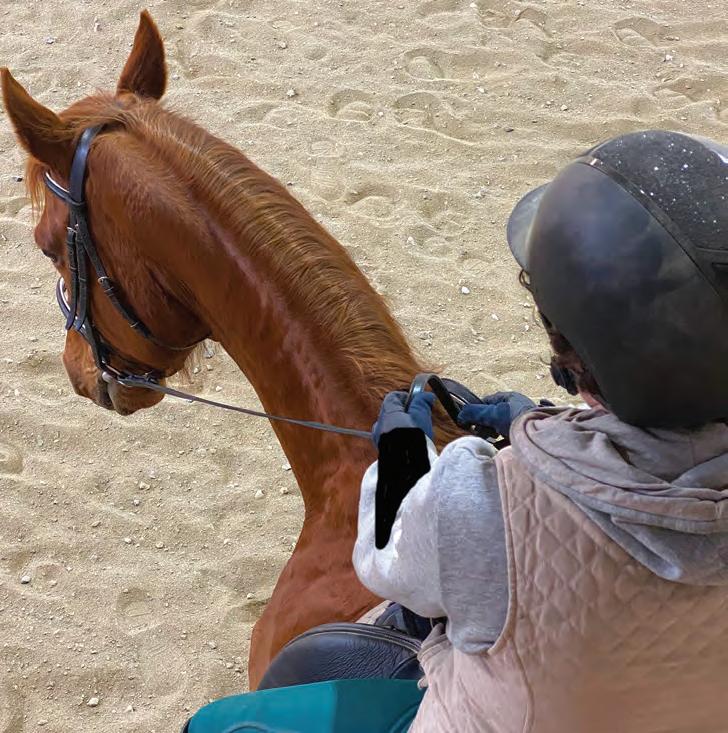


Calling all young riders! It’s time for some Fit To Ride Fun! This article is for those of you who want to have fun, improve your riding, and ensure your horses are happy and comfortable.
In general, movement and physical activity promote good mental and physical health, supporting motor skill development and social interaction. From exercises on and off the horse to interactive games and arena patterns, there are many ways to improve your
posture, balance, coordination, and overall fitness. As coaches and parents, recognizing that when youth associate exercise with enjoyment and fun rather than obligation they are more likely to be active throughout their teens and beyond. Explaining to young riders the benefits of fitness for themselves and their horses can help to build a foundation for a positive partnership and encourage life-long habits of physical activity and longevity in sport.
Equestrian sports require riders of all levels to have core strength, balance, flexibility, and coordination. These skills
By Sandra Verda-Zanatta SVZ Dressage & F2R Fit To Ride Pilates for Equestrians
are crucial to improve rider posture, alignment, and overall performance while promoting safety and horse wellbeing. A fit rider is better equipped to communicate effectively with their horse and maintain balance and symmetry while mounted.
A strong core is a key component for developing a stable, effective riding position. Core strength helps maintain stability in the saddle, enables better balance, and minimizes the risk of injury. Maintaining dynamic balance and having flexibility are also key factors for upright posture and an independent

When youth associate exercise with enjoyment and fun rather than obligation, they are more likely to be active throughout their teens and beyond.
seat. A combination of stability and relaxation promotes fluidity, improving the rider’s ability to follow the horse’s movement with ease. Seat independence gives riders the opportunity to develop “feel” and elasticity through their arms allowing consistent rein contact, while simultaneously using their seat and legs to influence the horse’s tempo, direction, and balance.
Being balanced in the saddle and developing an independent seat allows the rider’s weight to be distributed evenly
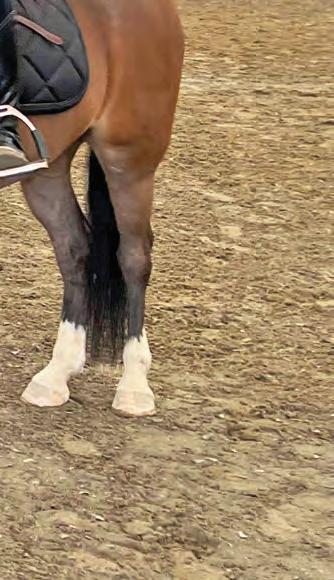
If you had to carry a backpack that was heavy and off-balance for a length of time you’d be uncomfortable and muscle-sore, just like a horse feels when the rider is uncoordinated and unbalanced.


Horses and ponies should be familiarized and comfortable with the exercise equipment.

There’s a reason some call it “stressage.” Like ballet, dressage is an art form that balances grace with strength and athleticism, a feat demanding extraordinary mastery of the body. Unlike ballet, in dressage that feat is dependent on cooperation between members of two different species — cue the stress! And when riders are stressed, so are the horses. As a result, riders sometimes turn to dubious methods in an attempt to gain control of their equine partner.
In an era of growing awareness of horse welfare, dressage has been under the microscope. Case in point: in Danish TV2’s 2023 “Operation X” broadcast “Secrets of the Horse Billionaire,” an undercover journalist, working as a groom for Helgstrand Dressage, uncovered significant ill-treatment of horses. The exposé resulted in Olympic medallist Andreas Helgstrand being banned from riding on the Danish national dressage team until at least 2025 — after the Paris Olympics.
More recently, American grand prix rider Cesar Parra was provisionally suspended by the Fédération Équestre Internationale (FEI) after videos emerged of him “training” horses in ways described by the FEI as
By Li Robbins
“disturbing and abhorrent.” But the issue isn’t just about individual bad actors. It’s about the beliefs humans hold when it comes to the needs and rights of horses. Enter Karen Rohlf. Her approach, dubbed “Dressage Naturally,” prioritizes a horse’s happiness over performance and competition. It focusses on making learning dressage enjoyable for both rider and horse and emphasizes healthy biomechanics. Rohlf, a former dressage competitor at the grand prix level, reminds us that dressage is meant to be for the horse, improving balance and freedom of movement as the horse learns to carry a rider with ease, a goal that doesn’t always equate to the highest scores come show day.

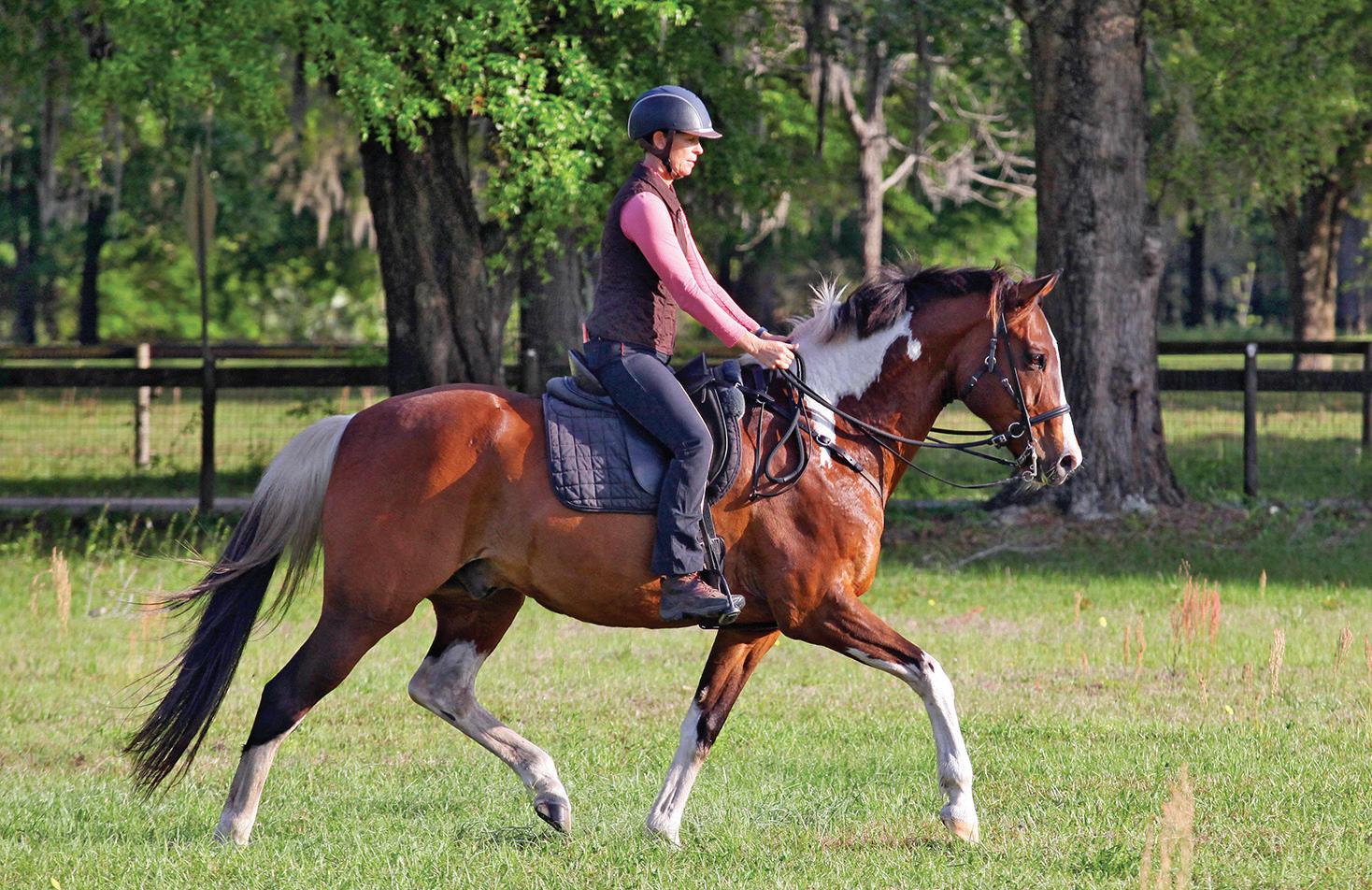
“Competitive riding is a skill that ought to be layered on top of artful training,” says Rohlf, “but too often the techniques are different. Competition riding is often about getting it to look like it’s working even if it isn’t — make it look better NOW. Training is the art of riding today so tomorrow is better.”
The competitive world is “a tough place to do right by horses,” Rohlf says, something that demands a willingness to not let external pressures (e.g., sponsors, money, wins) lead to decisions that are bad for horses. Most of all, doing right by a horse means letting go of what Rohlf calls “the assumption of obligingness,”
“Competitive riding is a skill that ought to be layered on top of artful
the belief that horses should work for us. Embracing this point of view means acknowledging that horses don’t inherently owe humans a thing; that it’s up to the rider to inspire the horse.
“Too many dressage riders struggle pushing their low-energy horses around a dressage arena with bigger and bigger spurs and more and more leg when simply doing the same movements or exercises in a field or along a trail will naturally inspire much better results,” she says, citing one example.
The concept of “relationship first, dressage second” has considerable appeal, as evidenced by Rohlf’s growing number of followers, including those listening to her podcast, Horse Training in Harmony, rated by Listen Notes in the top one

By Annika McGivern, MSc, Sport and Exercise Psychology

What do you believe is more important in our work with horses: knowledge or curiosity? It’s easy to see why knowing the answer is desirable, but valuing knowledge over curiosity can create pressure, frustration, and low confidence. Not being able to use curiosity as a mental skill can cause us to wind up in never-ending cycles of frustration and perceived failure in our journey as equestrians.
Curiosity is having an open mind and the willingness to ask questions. It is the ability to go looking for more information, inspiration, new ideas, and new ways of thinking. I like to think about curiosity as a secret weapon for the mental game of
performance. Just by learning how to become more curious, we can improve our self-confidence, regulate our nervous system, and regulate our emotions. Not only that, activating our curiosity is also an excellent way of practicing the mental
skill of directing focus. Curiosity allows us to shift our internal state very quickly from unhelpful to helpful. There is no doubt that curiosity is an extremely useful mental skill.
Imagine that you are trying to train a young horse to move sideways away from single-leg pressure. You are doing your best to ask clearly and consistently, but the horse is not getting it. She is also getting increasingly tense and reactive as you continue to ask. She is stepping forwards instead of sideways and beginning to barge through your “woah” aids. You are feeling increasingly frustrated and tense. You are struggling
to come up with a solution or an idea of what to try next. Unhelpful, self-critical thoughts start popping into your head, and you feel lost and discouraged. What might block you from being curious in a situation such as this? Lots of things, as it turns out! Putting pressure on yourself to know the answer can do it, or buying into the mindset that smart or talented riders should always know exactly what to do. When this happens, you can get caught up in the desire to prove yourself, but there isn’t space for curiosity in the pressure to always know the answer. Your own brain can sometimes block you from being curious through its desire to stick to the safety of the familiar, which can make new thinking and ideas, or new approaches, seem risky or uncomfortable. Despite the many obstacles to curiosity, we can teach ourselves to use it as a tool by learning to slow down, take a breath, and ask ourselves high-quality questions.
What are high quality questions?
The human brain loves answering questions and will immediately get to work finding an answer to any question we pose to ourselves. It’s important to recognise that all questions are not created equal. For example, asking ourselves Why am I terrible at this? would not be helpful because the answer is likely to be steeped in negative thinking and emotion. We want to encourage a more helpful style of thinking and creativity in the face of challenge. A high-quality question produces a new, helpful thought or perspective on the problem. Here are some examples of high-quality questions:
1 What else could I try?
2 How can I help my horse learn this?
3 How can I make this five percent better?
4 What do I need to learn to solve this challenge?
By remembering to use high-quality questions as a tool in our imagined scenario above, you will start to experience benefits such as increased confidence, less negative emotion, and a calmer nervous system.
Every time we get curious in the face of a challenge, we encourage new thinking, to help solve the problem. This proves to us that we’re capable of getting unstuck, moving through challenging situations, and finding a solution. We are strengthening our self-confidence muscle which helps us to believe in ourselves, and in our capacity to learn, improve, and solve problems.



Z was an exceptional stallion: beautiful, correct conformation, powerful and elegant movement, combined with incredible scope made him an all-around exceptional athlete. Intelligent, engaging personality, brave and willing partner, and a quick learner. His foals all seem to have his temperament. Leeto Z’s elegant, modern type, tremendous work ethic and even temperament are passed on to his progeny.
FROZEN SEMEN FEE: $1500 (includes $250 booking fee) LFG

DARCONIDO Z is a big, fancy, young stallion with incredible suspension and tremendous power. Brave and scopey through the chute, with an incredible working attitude. His pedigree boasts Darco, the stallion who has the most offspring in the world to have competed to Grand Prix level, and Contender who has dominated German breeding values for many years now and continues to produce exciting young jumpers.
STUD FEE: $1250 (includes $250 booking fee) LFG
NIGHT’S WATCH is an exciting new stallion prospect. His pedigree is filled with top level show jumpers like Voltaire, Furioso, Nimmerdor, Gotthard, Farn, and Le Mexico, who are all great progenitors of modern jumper breeding. Night’s Watch is noted for his style, balance, temperament and good mouth. On his dam’s side we have Cantos, a reknowned Contender son and Indorado, well-known for producing big, long lined horses with an unlimited amount of scope.
STUD FEE: $1250 (includes $250 booking fee) LFG


By Will Clinging, CJF, AJFC
Over the past 30 years, I’ve worked as a horse trainer, a cowboy, and a farrier. Today, I’m a full-time farrier and have always been very active in our horse community. I would like to share how my perspective has changed over the years and how my experiences as cowboy, farrier, and trainer have influenced how I work today. I also want to talk about safe spaces, safe horses, and share some insight into the farrier industry and what is happening with farrier training and qualifications.
I am a career horseman and have made my living on or under a horse for three decades. During that time, the type of horse I will get on or under has changed. As a younger man there were only two things that should have stopped me from working on many of the horses I was tasked with riding or shoeing — fear and common sense. I soon learned not to be afraid, so when things got a bit wild, I was not intimidated. I have never had common sense, but rather an uncommon sense that allowed me to understand the horse’s perspective. Once I understood how the horse would respond and what caused the horse to respond the way he did, it gave me the confidence to work through whatever storm I was in the middle of.
I do not have that same confidence anymore. In fact, when I was training, one thing I heard from many of my clients was that they did not have the confidence to ride or even handle their beloved horse. I did not understand then, but I understand now. Confidence is fragile,
and in my case, just dealing with the volume of difficult horses became a challenge. I never thought I could fail, but a few less-than-stellar results can plant the seeds of doubt.
Now I only work on horses’ feet, and although I have a few difficult ones, fortunately they are not the same scale of difficult that I used to deal with. As a farrier, it is no longer my job to train your horse to behave. It took me a lot of years to realize this. For good clients I will still take the time to make Pumpkin’s first set of shoes a good experience, but I don’t have the same amount of time to spend with the horse. I don’t get to know the horses the way I did as a trainer or a cowboy. I see them for an hour every six weeks, not an hour a day for three months or have them in my string for years.
Many farriers do not share my horsemanship skillset. While some are proficient horsemen and women, their enthusiasm for handling challenging horses may pale in comparison to simply avoiding the hassle.
From your farrier’s perspective, if they are injured working on Pumpkin, they’re out of work, and the hundreds of horses they care for are not going to get their feet seen to on time. They may need to ask colleagues in the farrier community to help them catch up their schedule. We all try to help an injured colleague as a way of paying it forward, knowing that one day we’ll need the help. Even if they don’t get hurt, the farrier doesn’t have enough time to spend with your unruly Pumpkin to get the job done safely without being late for the rest of the day’s appointments. Keep in mind that if your farrier does arrive late, there may be a good explanation.
If the farrier works with an apprentice who is less experienced, does your horse create a workplace hazard? I was at a stop today to trim a couple of young warmbloods that are four years old, and today was the first time since they were born that I was actually able to trim them without first having them tranquilized. That’s because the owner has finally started working with them to get them
Standing quietly to be shod during Hurricane Bill in 2009, this draft horse is a well-behaved client.
It isn’t the farrier’s job to catch your horse or train him to behave. For the safety of your farrier and everyone else who handles him, your horse should lead well, tie quietly, and be comfortable being handled and picking up his feet.
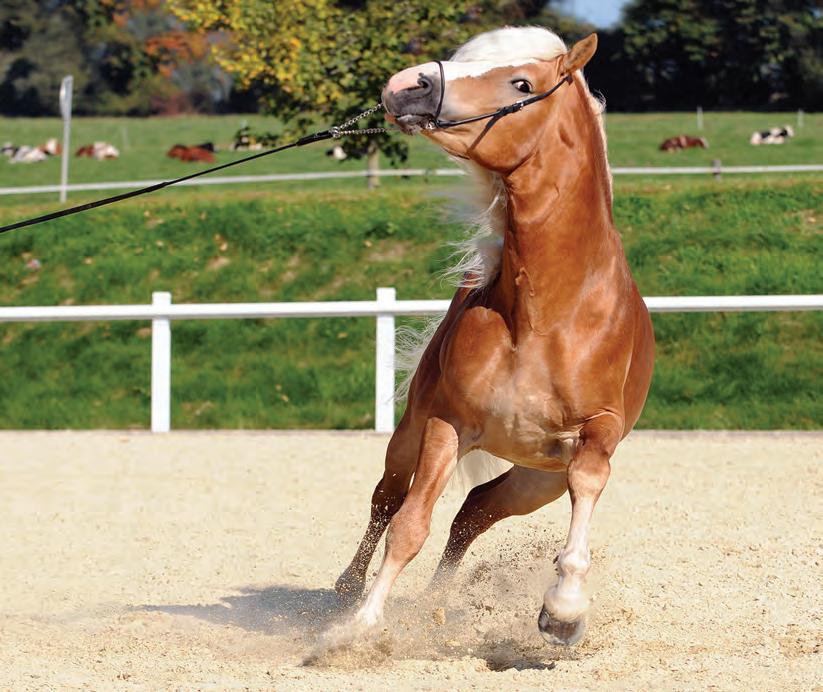

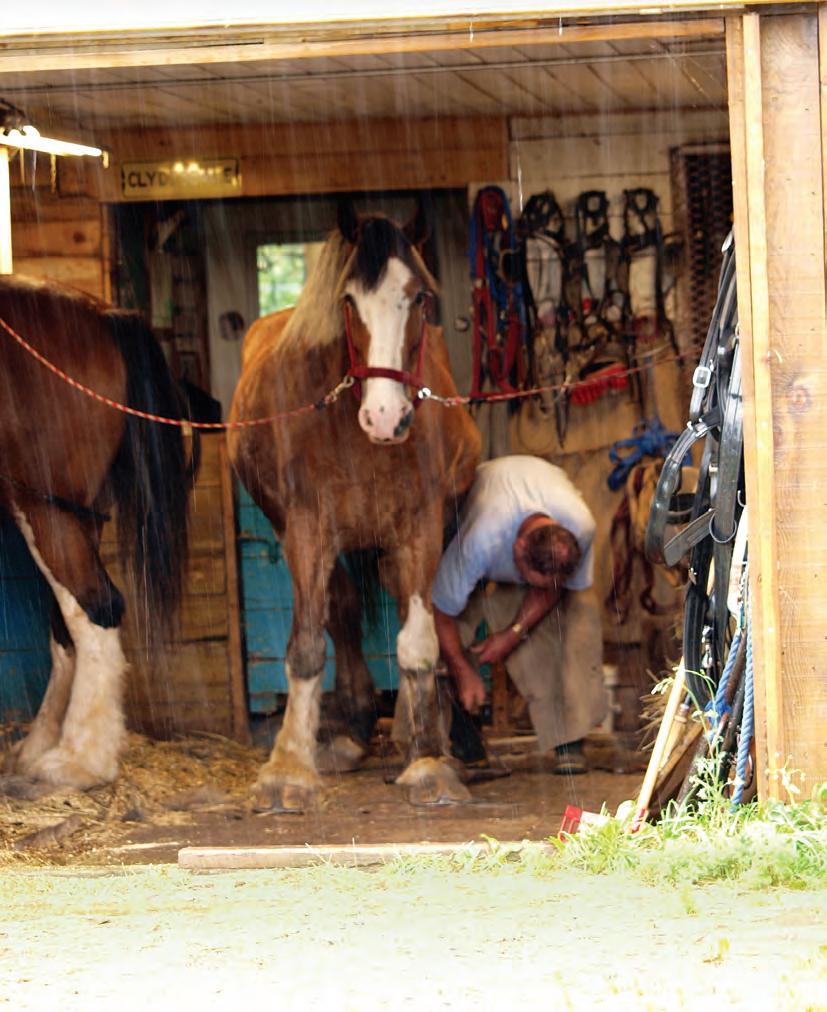



By Jacqueline Louie
The Painted Warriors Horseback Riding Backcountry Boot Camp is all about building skills and independence in riders of all levels. The five-day camp is one of a variety of horse- and naturebased programs offered at Painted Warriors Ranch, located in the foothills of the Canadian Rockies about an hour-anda-half northwest of Calgary, Alberta. Painted Warriors creates authentic outdoor experiences from an Indigenous perspective, based on co-owner Tracey Klettl’s Cree and Mohawk heritage and on the Ojibway heritage of her partner and
business co-owner, Tim Mearns.
The Horseback Riding Backcountry Boot Camp (Levels 1 and 2) is “a great program for experienced riders who don’t really have backcountry skills. To truly be able to go out and enjoy a backcountry trip when you’re educated, it’s safer,” Klettl says. “These are skills that don’t just make you more comfortable — they can potentially save your life. I think it gives people who want to ride in the mountains a holistic view — because being on the horse is just a small part of what happens.”

The backcountry boot camp is also designed for people who are not experienced riders but have always wanted to go into the backcountry.
“It gives them better insights as to how going out with an outfitter will feel and look,” says Klettl, a nationally certified English riding instructor. “It’s important for people to have the full picture and to be involved in that picture, right down to catching your horse, grooming and saddling it, and understanding how to put the horse away.”
“Preparation is everything,” adds



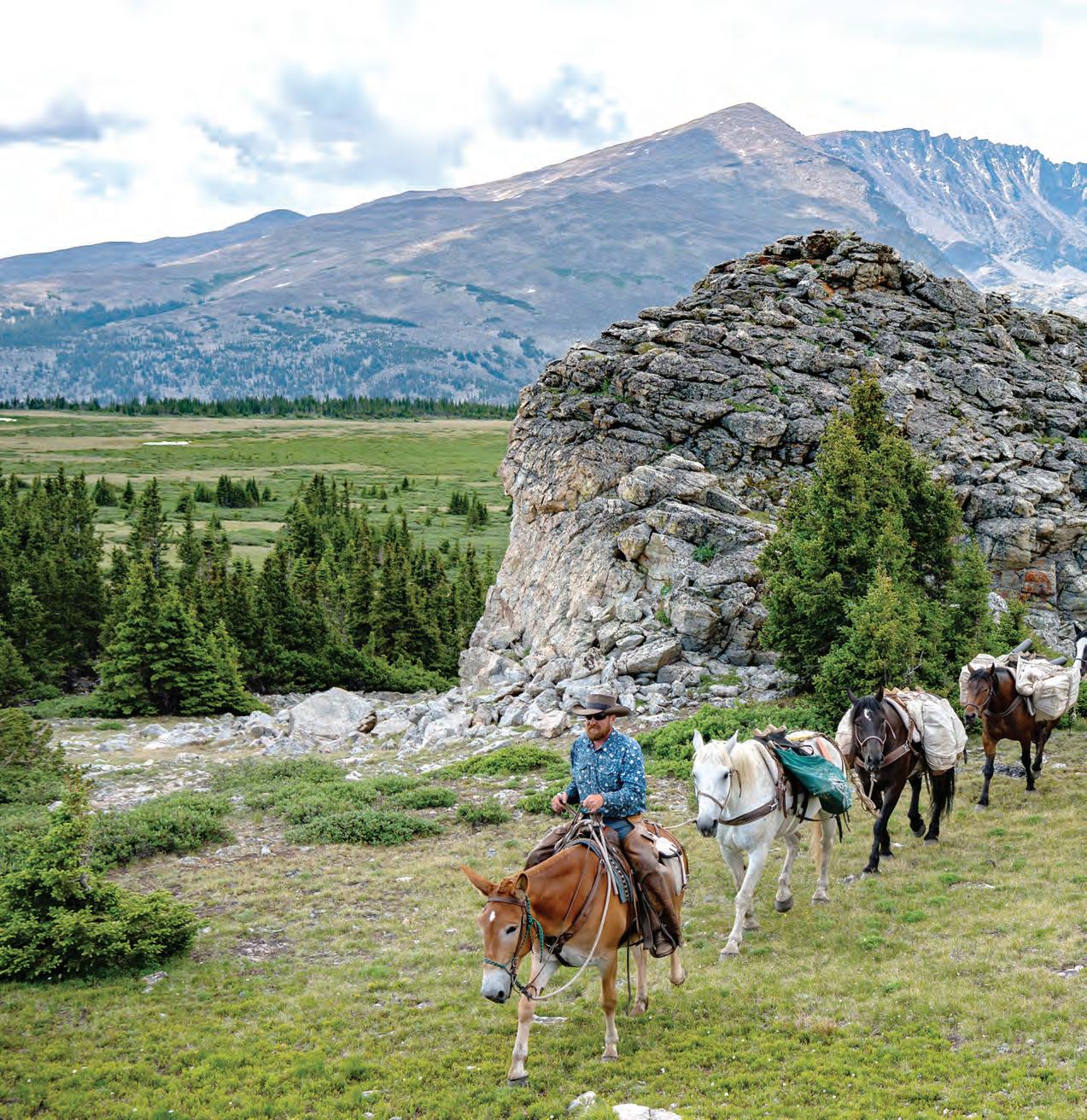
By Shawn Hamilton

There are many things that make a pack ride unique, such as the remoteness, the feeling of self-sufficiency, packing everything in by horse, and the sense of going back in time. On a four-day pack ride into the Cloud Peak Wilderness Area of Wyoming with Mark Patterson of Cross Country Equine, it was getting over the tricky parts of the trail to get to stunning scenery, accessible only by foot or horseback, that did it for me. Navigating through rushing waters, over wooden bridges, and across steep rocky terrain took us to pristine lakes, waterfalls, and mountaintops that offered breathtaking views of the Big Horn Mountains. Canyon, a draftcross gelding built for the job, carried me safely through even my scariest moments, making it a memorable and rewarding trip.

Mark picks me up in Sheridan, Wyoming early in the morning for our uphill drive to Spear-O-Wigwam ranch where the pack ride would begin. The road, recently graded, is only passable between June and September. “We are lucky, it can get really washed out,” Mark tells me.
Lush green valleys bordered by tall
pine forests lay in the foreground of the snow-capped Big Horn Mountains. Mark points to one of the peaks to show me where the ride will take us.
At an elevation of 8,500 feet, the snowtopped peaks reflect onto Cloud Peak Reservoir, a mountain lake below Cloud Peak, as we drive through the entrance of Spear-O-Wigwam ranch with its 100th anniversary banner proudly on display.
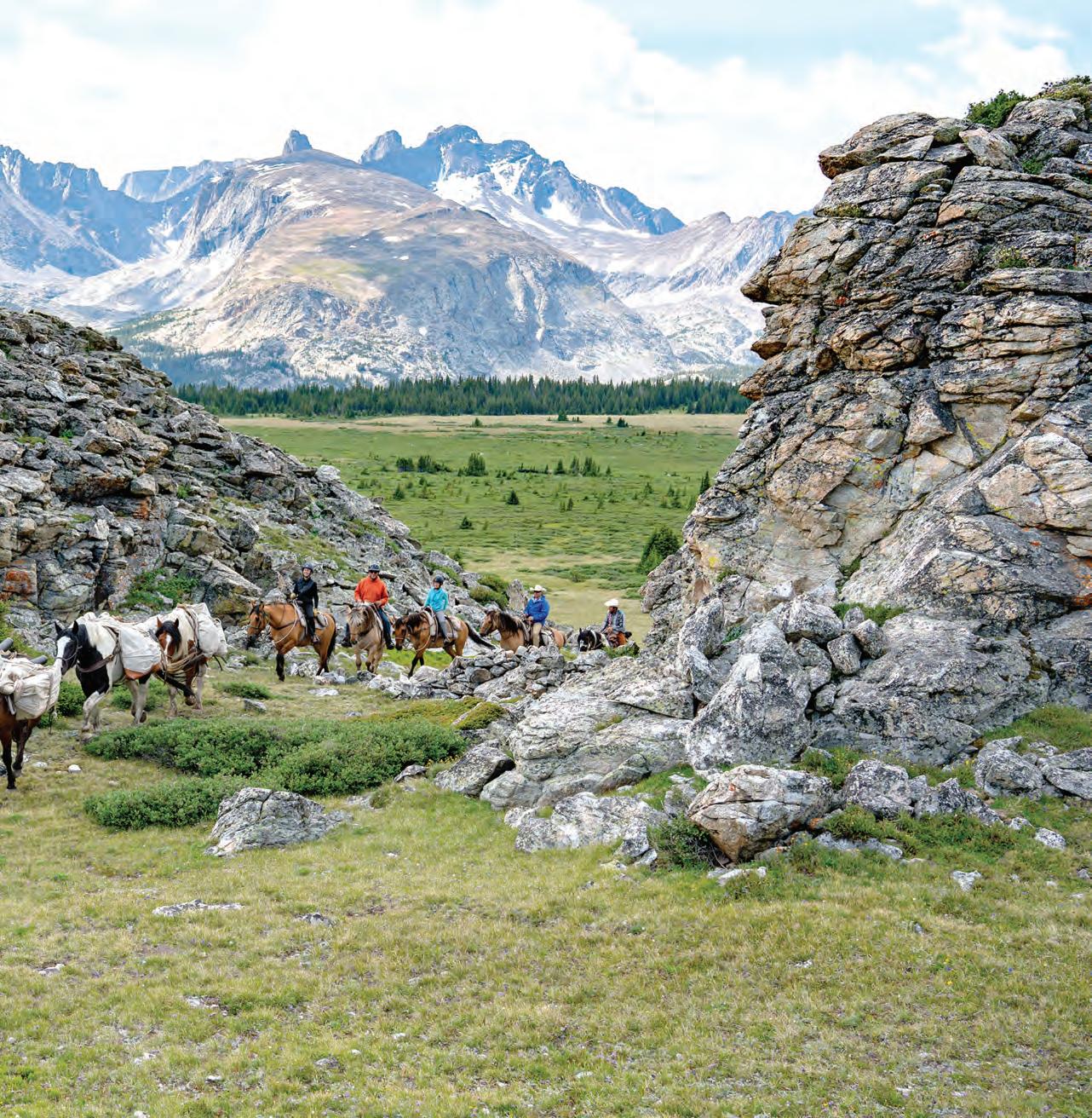
Originally built in 1923 by Willis Spear, the main lodge was constructed to resemble a wigwam as an eight-sided lodge, 40 feet in diameter; later the shaft and spearheadshaped buildings were added. From the air, the building shape resembles the Spear cattle brand. Over the years, thousands of guests have come here to explore the high country and experience the rugged natural beauty of the area.
Spear-O-Wigwam is named to represent a combination of ranching life and native culture. Purchased in 2011 by the Northern Wyoming Community College District, it was used by Sheridan College as a nature retreat. In March of 2020, a group of investors with local ties bought the property with a vision of returning it to its original guest ranch roots, providing fishing, horseback
riding, biking, kayaking, and canoeing. There are multiple cabins on the 17-acre grounds, with trails leading to the vast Cloud Peak Wilderness Area, a 189,039acre parcel designated for preservation by The Wyoming Wilderness Act of 1984 Making our way to the dining room of the main lodge, we pass the crackling fire in the huge stone fireplace of the lounge area. Arriving just in time for breakfast,




